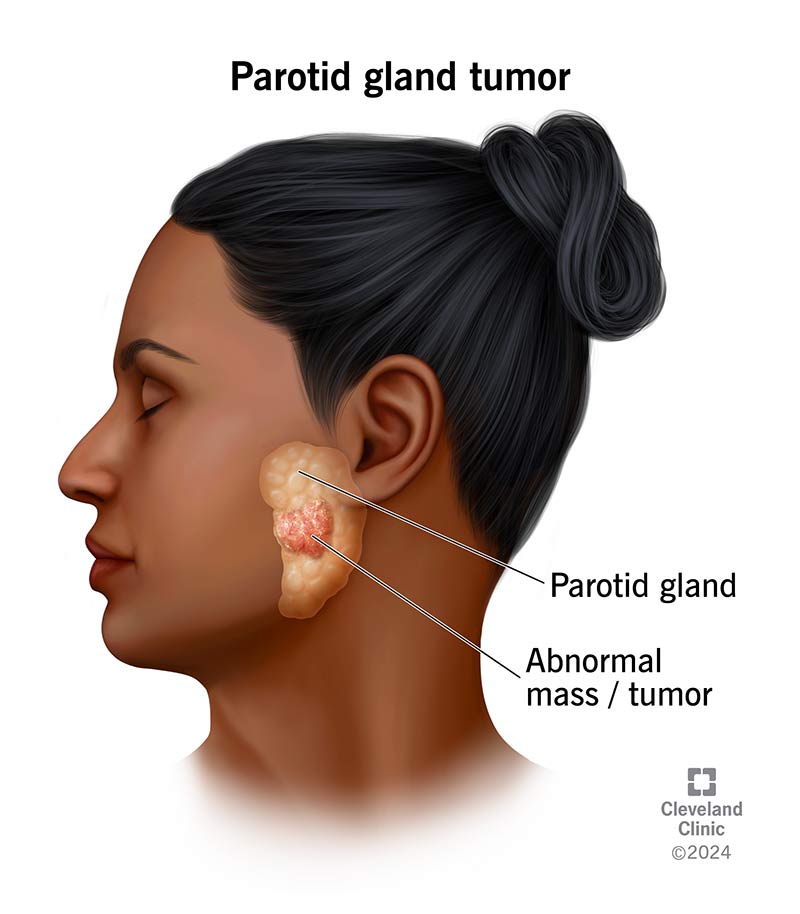A parotid gland tumor is a rare tumor on one of your salivary glands. Most parotid tumors are benign (noncancerous), but they can be cancerous. Both types cause a lump in front of one of your ears. Surgery treats both types and cures noncancerous parotid gland tumors. Providers may also use radiation therapy to treat cancerous tumors.

A parotid gland tumor is an abnormal mass or tumor on your parotid gland. Your parotid gland is the largest of your three salivary glands and is found just in front of each of your ears. Most parotid gland tumors are noncancerous (benign), but about 20% are malignant (cancerous). A cancerous tumor on your parotid gland is the most common form of salivary gland cancer.
Both tumor types are rare. Each year, cancerous parotid gland tumors affect 1 in 100,000 people worldwide. Experts don’t know the exact number of people who have noncancerous parotid gland tumors but estimate the condition may affect 1 to 6 in 100,000 people worldwide.
Cleveland Clinic is a non-profit academic medical center. Advertising on our site helps support our mission. We do not endorse non-Cleveland Clinic products or services. Policy
Both types of parotid tumors cause lumps that develop in front of one of your ears. But cancerous tumors are more likely to cause pain than noncancerous tumors. Other cancerous parotid gland tumor symptoms include:
Most parotid gland tumors grow very slowly. You can have one for months, years or even decades before you have symptoms. Often, healthcare providers find tumors while doing imaging tests for unrelated health issues.
Experts aren’t sure exactly what causes these cancerous and noncancerous tumors. Research suggests some common possible causes include using tobacco or having radiation therapy for head and neck cancer.
Providers will do a physical examination focused on your head and neck. They’ll ask when you noticed the lump and if it’s grown. They may order the following tests:
Analysis also establishes the cancerous tumor’s stage and grade. The tumor stage is based on tumor location and size, and whether the tumor has spread to nearby lymph nodes or other areas of your body. The tumor grade is how cancerous cells appear when viewed under a microscope. Tumor grades run from low to high.
Providers use test results to develop treatment plans and a prognosis, which is what you can expect to happen after treatment.
Treatment typically involves surgery to remove the tumor. Surgery cures noncancerous tumors and may cure cancerous ones, as well. But cancerous parotid gland tumors can come back (recur).
Parotidectomy, which is surgery to remove part or all of your parotid gland, is the most common treatment for cancerous and noncancerous tumors. People with cancerous tumors also receive radiation therapy after surgery.
You may not be able to prevent these tumors. Avoiding known risk factors like using tobacco may lower your risk.
That depends on whether you have a cancerous or noncancerous tumor. Surgery typically cures noncancerous parotid tumors. It may cure cancerous tumors that healthcare providers detect and treat before they can spread. But these cancerous tumors can come back (recur) years after treatment.
If you had treatment for a cancerous parotid gland tumor, your healthcare provider will schedule regular checkups, including imaging tests, for up to 20 years after treatment. Your checkup schedule may look like the following:
| Post-treatment timeline | Checkup schedule |
|---|---|
| Year 1 | Every one to three months. |
| Year 2 | Every two to six months. |
| Year 3 to 5 | Every four to eight months. |
| Year 5 and beyond | Every 12 months. |
| Post-treatment timeline | |
| Year 1 | |
| Checkup schedule | |
| Every one to three months. | |
| Year 2 | |
| Checkup schedule | |
| Every two to six months. | |
| Year 3 to 5 | |
| Checkup schedule | |
| Every four to eight months. | |
| Year 5 and beyond | |
| Checkup schedule | |
| Every 12 months. |
Survival rates are estimates of the percentage of people with this condition who were alive five years after diagnosis. Rates vary widely depending on factors like:
Mucoepidermoid carcinoma (MEC) is the most common subtype of cancerous parotid gland tumor. The survival rate ranges from 86% for low-grade tumors to 22% for high-grade tumors.
Here are some things to keep in mind when you think about survival rates for cancerous parotid gland tumors:
If you’re receiving treatment for a cancerous parotid gland tumor, ask your healthcare provider what you can expect.
Cancerous parotid gland tumors can come back. Here are some suggestions for taking care of yourself after treatment:
You’ll have frequent follow-up appointments if you had treatment for a cancerous parotid gland tumor. But you should contact your healthcare provider if you notice changes like a new lump developing in front of one of your ears.
A note from Cleveland Clinic
Parotid gland tumors are rare. They’re usually benign (noncancerous) but can be cancerous. The most common symptom is a lump that develops in front of one of your ears. If you notice swelling or a lump in that area, talk to a healthcare provider. They’ll do tests to find out what’s affecting your parotid gland and recommend treatments.
Last reviewed by a Cleveland Clinic medical professional on 03/11/2024.
Learn more about our editorial process.
Cleveland Clinic is a non-profit academic medical center. Advertising on our site helps support our mission. We do not endorse non-Cleveland Clinic products or services. Policy